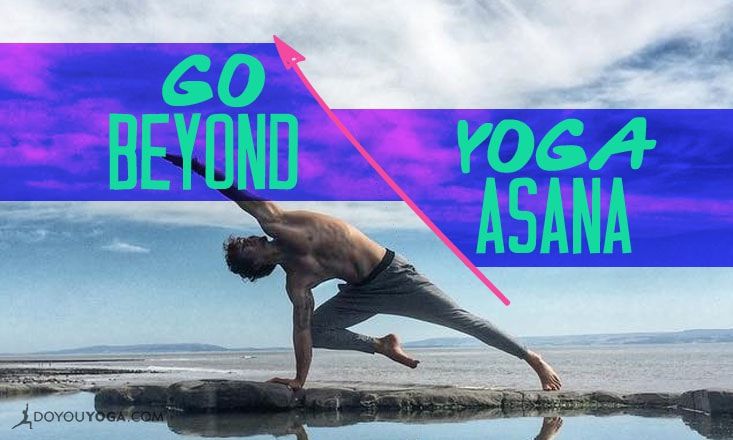Our physical practice, also known as asana, is the tip of the iceberg when it comes to yoga. While these physical poses and shapes make us feel wonderful, get our blood moving, engage our muscles, and often tantalize our brain, they are actually not the only way to use yoga to improve your health and expand your world.
The philosophies behind yoga center directly around health and wellness. While you may already be seeing huge differences in your wellbeing simply by performing the postures regularly, those benefits grow exponentially when you begin to take your practice off the mat and delve into some of the philosophies behind the postures.
Some of these philosophies are simply listed in something called “The 8-Limbed Path.” Here are just a few ways that using the 8 Limbs could take your yoga practice beyond asana and improve your life even more.
Injury Prevention
The benefits of deriving a deeper focus on your mat, and in life, is born from practicing the art of listening to each individual body part one at a time. This is sometimes called “Yoga Nidra” and is a meditative yogic practice in and of itself.
In the 8 Limbs, this practice to learn and be able to isolate the senses one at a time to cultivate that deep focus and listening ability would fall under Pratyahara. It will help you better understand the abilities and limits of your body, and therefore, prevent injury or illness.
Make a Habit of Clean Living
This pertains to so many corners of our lives. Yes, cleaning up your own personal habits and eating healthy is where it begins, but what we end up seeing is that after a time, this “clean living” practice doesn’t just pertain to one’s diet and lifestyle.
Cleaning up your immediate environment is a result of smartening up personal hygiene habits and becoming aware of harmful eating habits. Progressively we begin to take this ideal into a more broad setting; recycling, for example, is a broad way to practice Saucha, or clean living, and it happens without much thought once you have become aware of the philosophy at the heart of your yoga practice.
Improve Your Decision-Making Skills
Sitting in challenging yoga postures teaches us to sit with the discomfort and witness all the challenging things that come up without reacting to them.
Take that one step further and try sitting in a comfortable seat where it is much easier to get distracted and want to get up. Focus on one specific thing. Resolve to stay no matter what arises and try to simply be a witness to what comes to the surface.
This kind of meditation (Dharana) builds patience and commitment, and it will guide you from indecisive and choppy thoughts and into a place of smooth, cool, and calm decision-making bliss.
Notice that the more you practice this, the less you tend to react negatively in a frustrating or confrontational situation, and the more you can pause to make beneficial, accurate, and thoughtful decisions under pressure.
Relationship Improvement and Development
Continuing on the same thread, learning to be silent with yourself in any kind of meditation, and listening to the tiniest physical and emotional sensations as they arise, can teach you a LOT about how to listen to the important people in your life more actively.
Not only will you begin to actually hear what people are saying without getting distracted or inserting your own words or opinions, you may well pick up on things left unsaid. This will go a long way in how you relate to others—and not just with fellow yogis or even fellow humans. You’ll begin to practice and live the principle of Ahimsa.
Having listened to the words and body language around you, you will ultimately be able to respond with more thought and respect, thus preventing disharmony and providing more appreciation to those in your life that are special to you.
Stress Prevention and Management
Being able to effectively cope with daily life stresses is a direct result of taking care of yourself emotionally and physically. Yes, your physical yoga practice does this for you, but what about those days you can’t make it to your mat?
Wouldn’t it be nice to have a tool you can draw from in the middle of a meeting, while sitting in traffic, or when you receive bad news on the phone?
Calming your mind and resetting your nervous system can be cultivated with breathing techniques or Pranayama.
A lot of doctors and therapists are now prescribing breathing techniques as supplementary ways of coping with anxiety, stress, and depression, and many of these techniques have deep roots in our yogic breathing techniques. Coincidence? Not at all—these techniques work.
We do not often have an opportunity to engage the parasympathetic nervous system (which is the opposite of fight or flight) in a way that deeply relaxes us. Using breathing techniques can help you reach this place with more ease, cultivating more nourishing sleep, and improved blood circulation and adrenal health.
So, as much as it is highly recommended to get on your mat and practice asana, you might also want to consider taking your practice off the mat to reap even more benefits!
The 8-Limbed path is a direct road towards better living and you may find you already align with many of its values. Just remember, living well is not a check list. These are ideals to be worked on at ALL times and will never be “finished.” Each limb becomes quite personal to its practitioner and there is no wrong or right way to go about bringing it into your life.
Image credit: Dan Morgan


